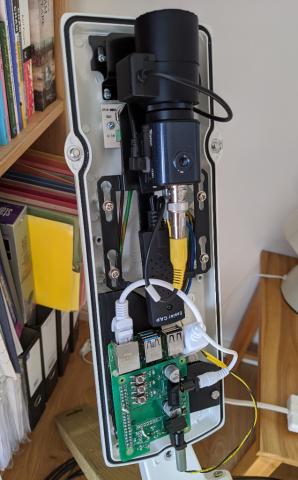› Forums › Meteors › Refocussing meteor cameras › Thanks!
Thanks – that’s interesting.
My lens doesn’t have a grub screw to hold the focus, so perhaps a bit of tape or glue is the way to go. The quality of focus doesn’t seem to strongly affect the number of meteors I record, so I may be being too picky. I guess meteors are moving so quick that they’re inevitably spread over many pixels, so having a soft focus doesn’t make such a difference. The one benefit to a really sharp focus is that I see a lot more stars, which is handy for calibration.
I use an easycap usb dongle to connect the Watec 902H2 Ultimate to the RPi. See the photo below. The whole setup fits inside a Genie TPH2000 enclosure, powered via power-over-ethernet so only one cable is needed. A custom Pi Hat converts the 48V supply from the PoE into a 5V supply for the RPi and a 12V supply for the camera. There’s a transistor to allow the RPi to turn the camera on/off via one of the GPIO control lines. Previously I was using a RPi model 2, which had issues with dropping frames. But I’m now using a RPi model 4, which is a pretty fast machine. Very occasionally frames still get dropped, possibly due to USB errors, but 99% of the time it’s fine.
At some point I’d like to get my software to produce output in a compatible format with UFO Capture, so that we can share data. At the moment my biggest concern is calibrating the pointing, though. I’m doing a polynomial fit to the radial distortion in the lens, and then using astrometry.net to determine the pointing of each image. I periodically take one-minute exposures through the night for this purpose. I then take the median of all the pointings determined each night to arrive at a single (alt, az) estimate for each camera each night.
It works up to a point… but I’m still seeing ~5 pixel offsets in the fitting a lot of the time… which isn’t very good.

